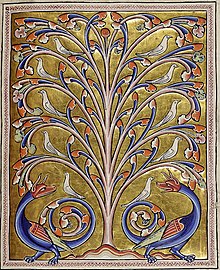Peridexion
The tree peridexion ( ancient Greek περιδέξιον) is a (mythical) tree (δένδρον dendron ), which is mentioned in the Physiologus , the most famous early Christian compendium on the symbolism of animals (as well as some stones and plants). It is the only tree the Physiologus lists.
properties
The tree peridexion (translated "double helper") grows in India. Pigeons nest on it because it has two outstanding properties: on the one hand, its fruits are healthy and digestible; on the other hand, the tree and its shadow repel the snake (δρἁκων), which is the deadly enemy of the pigeons. Only if the pigeon strays from the tree can it be killed by the snake.
Morality according to Physiologus
The tree is interpreted as a god who protects people. The doves represent the faithful Christians. They feed on the fruits of the Spirit. The Physiologus points out that they will find hope and protection with God and in the shade of the Tree of Life. But if the Christians stray from the path and move away from the tree of life, then the devil can easily destroy them.
Derivation
In his commentary on the Physiologus, Otto Schönberger refers to Pliny the Elder , who in his Naturalis historia reports on the ash that keeps the snake away. Possibly the story originated from a connection between the Pliny passage and the New Testament parable of the tree of life .
literature
- Christian Schröder: The Millstätter Physiologus. Text, translation, comment. Würzburg 2005 ( ISBN 3-8260-2736-1 )
Web links
- Peridexion tree. Description and medieval illustrations in The Medieval Bestiary (English)
- The Aberdeen Bestiary: Folio 64v - De arbore que dicitur perindens / Of the tree called perindens. Reproduction and transcription Latin / English, University of Aberdeen
Remarks
- ↑ Latin Perindens or Circa dexteram
- ↑ on the text in German translation and on the origin of the name see Jost Gippert: Physiologus. The processing of ancient natural myths in an early Christian text. 1994, pp. 170-175 (PDF; 176 kB).
- ^ Otto Schönberger: Physiologus. Greek / German. Stuttgart 2001 (= Reclams Universal Library No. 18124), p. 122 ( ISBN 3-15-018124-0 )
